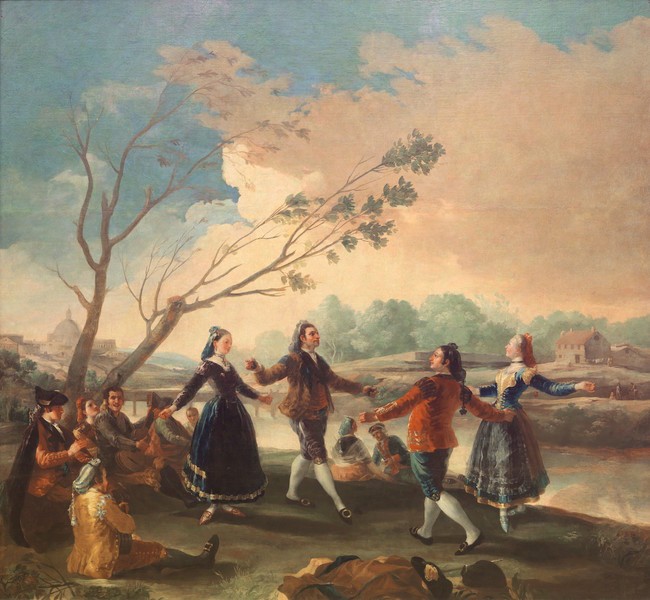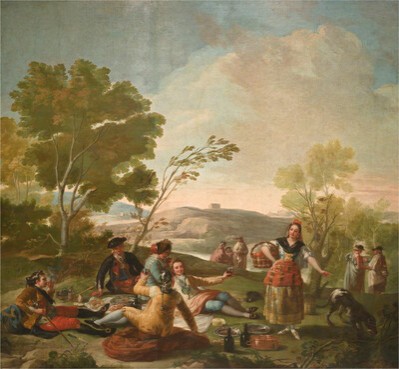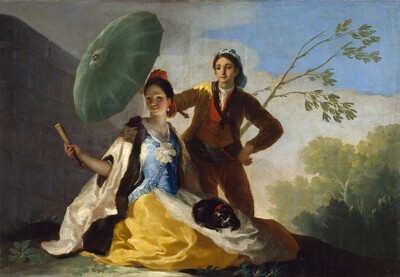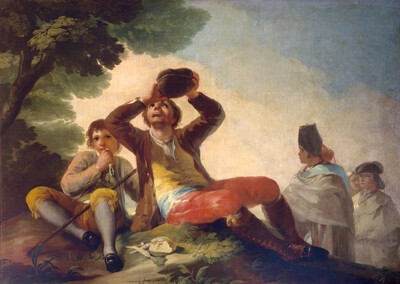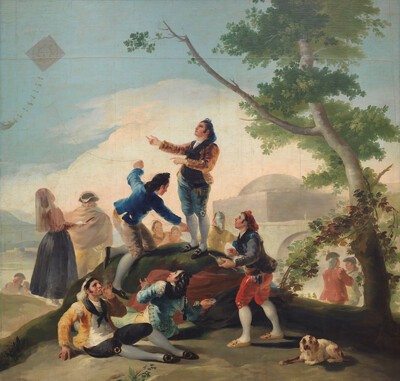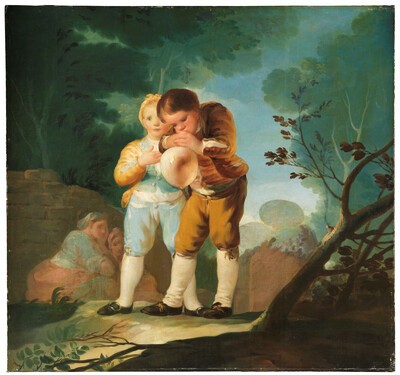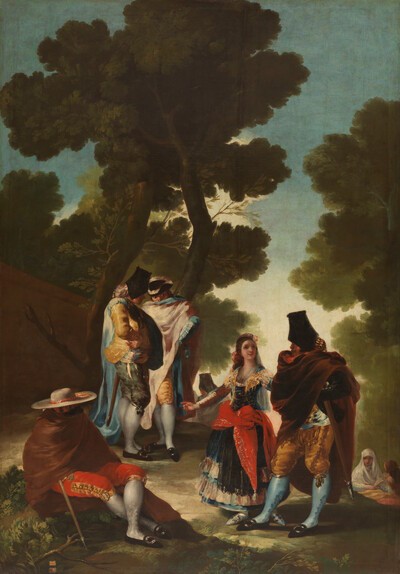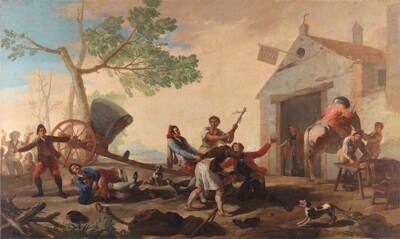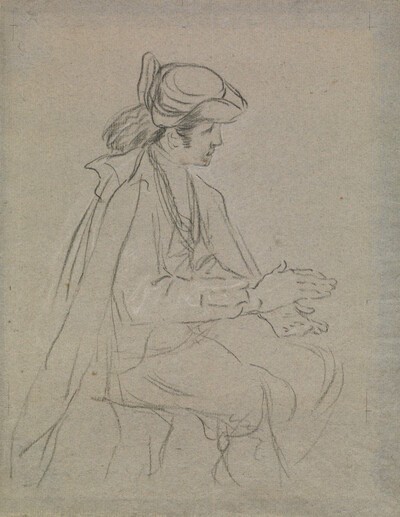- Cronología
- 1777
- Ubicación
- The Prado National Museum. Madrid, Madrid, Spain
- Dimensiones
- 272 x 295 cm
- Técnica y soporte
- Oil on canvas
- Reconocimiento de la autoría de Goya
- Documented work
- Titular
- El Prado National Museum
- Ficha: realización/revisión
- 01 Jan 2010 / 14 Jun 2023
- Inventario
- (P00769)
- Otros títulos:
-
Dance at San Antonio de la Florida (El baile en San Antonio de la Florida)
Round Dance (El baile de ronda)
This work forms part of the series of ten cartoons of country themes for tapestries designed to decorate the dining hall of the Prince and Princess of Asturias in the palace of El Pardo. This one was delivered on 3 March 1777.
Around 1856 or 1857, the cartoon was moved from the Royal Tapestry Factory of Santa Bárbara to the Royal Palace in Madrid. On 15 February 1870, it was taken to the Prado Museum under orders given on 18 January and 9 February.
This cartoon is of Goya's own invention, something which he himself emphasizes on repeated occasions on the invoices for this first series of independently-made cartoons in order to distance himself from the influence of Francisco Bayeu.
The composition resembles that of The Picnic, the cartoon of the tapestry that is this one's pair, and its dimensions are very similar. It is a landscape based on the different heights of terrain across which the figures are distributed. The Manzanares river acts as a horizontal axis, separating the foreground from the background. In the foreground, two majos and two majas are dancing a seguidilla, whilst other figures either play musical instruments or clap in time to the music.
The setting was identified thanks to the description made by Goya on the invoice. The dome that can be seen at the back on the left belongs to the church of San Francisco el Grande, next to the Royal Palace. On the right, also at the back, over the other side of the river, we can see the grounds of the Casa de Campo. Gassier and Wilson considered this to be, in topographic terms, one of Goya's most convincing landscapes.
In the artist's handling of the paint we see brushstrokes that are more fluid and colours that are more vivid - Goya is finding his own personal style.
There exists a preparatory drawing (rec. no. ?) of the man clapping in time to the music.
Francisco Zapater y Gómez owned a preliminary sketch for this cartoon, which came from his uncle, Martín. This sketch was exhibited in the Hispanic-French Exhibition of Zaragoza (1908) when it was the property of Timoteo Pamplona and is only known thanks to a photograph in the Coyne photographic archive (AHPZ-Government of Aragón), given that the whereabouts of the sketch itself are now unknown.
-
Goya. 250 AniversarioMuseo Nacional del PradoMadrid1996consultant editor Juan J. Luna. From March 29th to June 2nd 1996
-
Goya en Madrid. Cartones para tapices 1775-1794Museo Nacional del PradoMadrid2014p. 169
-
L'œuvre peint de Goya. 4 volsParís1928-1950vol. I, p. 61, cat. 2
-
Tapices de GoyaMadridPatrimonio Nacional1946pp. 92, 203, cat. 11 y láms. 49-53
-
Vie et ouvre de Francisco de GoyaParísOffice du livre1970pp. 45-46, 75, 85, cat. 74 y 46 (il.)
-
BarcelonaPolígrafa1970vol. 1, pp. 40-41, 245, cat. 63
-
L’opera pittorica completa di GoyaMilanRizzoli1974p. 94, cat. 70 y lám. I
-
Francisco de Goya, 4 vols.ZaragozaCaja de Ahorros de Zaragoza, Aragón y Rioja1980-1982vol. I, pp. 83, 86
-
Imagen de GoyaMadridLumen1983pp. 59, 64, 65
-
Francisco de Goya, cartones y tapicescol. col. "Espasa Arte"Espasa Calpe1987pp. 72-74, 84, 152, 184, 249, cat. 15C y
-
Francisco de Goya. Los cartones para tapices y los comienzos de su carrera en la corte de Madridcol. col. "Ensayos de Arte Cátedra"MadridCátedra1987pp. 47, 58, 59-62, 89 y p. 60 (il.)
-
Goya. 250 AniversarioMadridMuseo del Prado1996pp. 287-288, cat. 8 y p. 73 (il.)
-
Salas del Palacio Real de El Pardo para las que se tejieron tapices sobre cartones de Francisco de Goya: identificación de las habitaciones y ajuste de las obras de Goya en los alzados de las paredesin HERRERO CARRETERO, Concha (curator, Tapices y cartones de Goya (catalogue of the exhibition organizated at the Palacio Real de Madrid, from may to june 1996)MadridPatrimonio Nacional, Goya 96, Lunwerg1996p. 167 (il.)
-
Goya en Madrid. Cartones para tapices 1775-1794MadridMuseo Nacional del Prado2014p. 169
